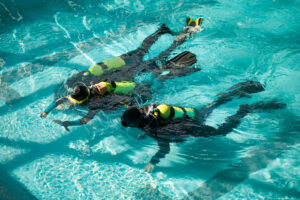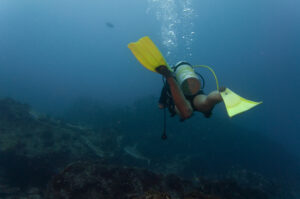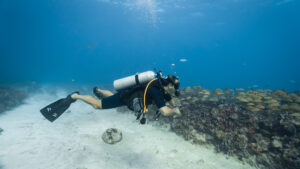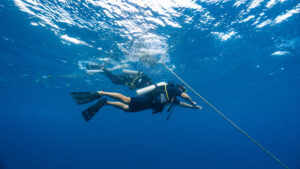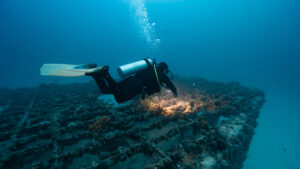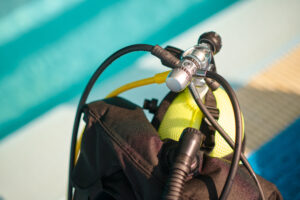What is a Dive Computer?
A dive computer is an indispensable piece of scuba diving equipment that assists divers in monitoring the time and depth of their dives. It also calculates nitrogen levels in the body and determines a safe ascent profile using mathematical algorithms. The purpose of this device is to enhance diver safety, extend bottom time beyond what dive tables allow, and prevent decompression sickness. Many dive computers also provide additional information such as water temperature, dive logs, and the pressure of remaining breathing gas.
History and Development of Dive Computers
The concept of a dive computer originated in the early 1960s, with the invention of the first decompression meter by the French scientist, Maurice Fargues. In the 1980s, the Finnish company, Suunto, introduced the SME-ML, the first commercially available dive computer. Over the years, dive computers have evolved in sophistication and functionality, incorporating advanced algorithms and innovative features to keep up with the increasing demands of recreational and technical divers.
How Dive Computers Work
Dive computers use mathematical algorithms to calculate a diver’s decompression status. These algorithms consider factors such as dive depth, duration, and previous dive profiles, and use this information to provide real-time decompression information. The most commonly used algorithms are the Bühlmann ZH-L16, VPM (Varying Permeability Model), and RGBM (Reduced Gradient Bubble Model).
Key Features of Dive Computers
Depth and Time Monitoring
Dive computers continuously track the depth and time of a dive, displaying this information on a screen that is easily readable underwater. This helps divers to maintain their planned dive profiles and observe depth and time limits.
Nitrogen Saturation and Desaturation Calculations
Dive computers calculate the amount of nitrogen absorbed by a diver’s body tissues during a dive, providing essential information for preventing decompression sickness. They also display the remaining no-decompression time, which is the maximum dive duration before mandatory decompression stops are required.
Ascent Rate Monitoring
As a diver ascends, the dive computer monitors the ascent rate, providing real-time feedback and alerts if the ascent is too fast. This helps divers avoid complications related to rapid ascents, such as decompression sickness and barotrauma.
Decompression Stop Information
If a diver exceeds the no-decompression limit, the dive computer calculates and displays the required decompression stops, guiding the diver through a safe ascent.
Dive Log
Many dive computers automatically record dive data, including maximum depth, dive duration, and water temperature. This information can be downloaded to a personal computer or smartphone, creating a digital dive log for easy reference and analysis.
Gas Integration
Some dive computers can be paired with a transmitter that connects to the diver’s air tank, providing real-time information on the remaining breathing gas pressure. This feature allows divers to monitor their air consumption and plan their dives accordingly.
Multigas Capability
Advanced dive computers support the use of multiple gas mixes, such as nitrox and trimix. This feature enables divers to switch between different breathing gases during a dive, optimizing their decompression profiles and extending bottom time.
Digital Compass
Many dive computers include a built-in digital compass, helping divers navigate underwater and maintain their bearings.
Audible and Visual Alarms
Dive computers are equipped with alarms that alert divers to critical situations, such as low air pressure or rapid ascent rates. These alarms enhance diver safety and awareness.
User-Replaceable Batteries
Most dive computers have user-replaceable batteries, making it convenient for divers to change batteries as needed.
Selecting the Right Dive Computer
When choosing a dive computer, divers should consider factors such as their diving experience, the type of diving they plan to do, and their budget. Here are some key aspects to consider when selecting the perfect dive computer:
Type of Diving
The type of diving you plan to engage in will heavily influence the features you require in a dive computer. Recreational divers may only need basic features, while technical divers or those pursuing advanced certifications may require more sophisticated functionalities, such as multigas capabilities and customizable decompression algorithms.
Display Type and Readability
Dive computers come with various display types, including LCD, OLED, and color screens. It is essential to choose a display that is easy to read underwater and provides clear visibility in various lighting conditions. Some dive computers also offer customizable screens, allowing divers to personalize the information displayed according to their preferences.
Wrist or Console Mounted
Dive computers are available in wrist-mounted or console-mounted options. Wrist-mounted dive computers are more portable and convenient to use, while console-mounted computers are typically integrated into the diver’s regulator setup. Personal preferences and convenience should guide your choice between these two options.
Connectivity and Compatibility
Many modern dive computers offer connectivity options, such as Bluetooth or USB, enabling divers to download their dive logs onto a personal computer or smartphone. Ensure that the dive computer you choose is compatible with your devices and operating systems.
User-Friendliness
A dive computer’s user interface should be intuitive and easy to navigate, especially when underwater. Look for dive computers with simple button layouts and clear menu structures.
Durability and Reliability
Given the harsh conditions of underwater environments, it is crucial to choose a dive computer that is durable and reliable. Opt for reputable brands known for their high-quality products and excellent customer support.
Price
Dive computers come in various price ranges, from entry-level models to high-end devices with advanced features. Assess your diving needs and budget before making a decision.
Maintenance and Care
To ensure the longevity and accuracy of your dive computer, it is essential to follow proper maintenance and care procedures. Rinse the dive computer thoroughly with fresh water after each dive, taking care to remove any salt or debris. Store it in a cool, dry place away from direct sunlight, and replace the battery as recommended by the manufacturer. Regularly inspect the device for signs of wear, damage, or corrosion, and address any issues promptly.
Key Takeaways
A dive computer is an essential tool for scuba divers, providing valuable information to enhance safety and optimize dive experiences. By understanding the features and considerations involved in selecting the right dive computer, divers can make informed decisions that best suit their individual diving needs and preferences. Proper maintenance and care will ensure the longevity and reliability of this indispensable piece of scuba diving equipment.




